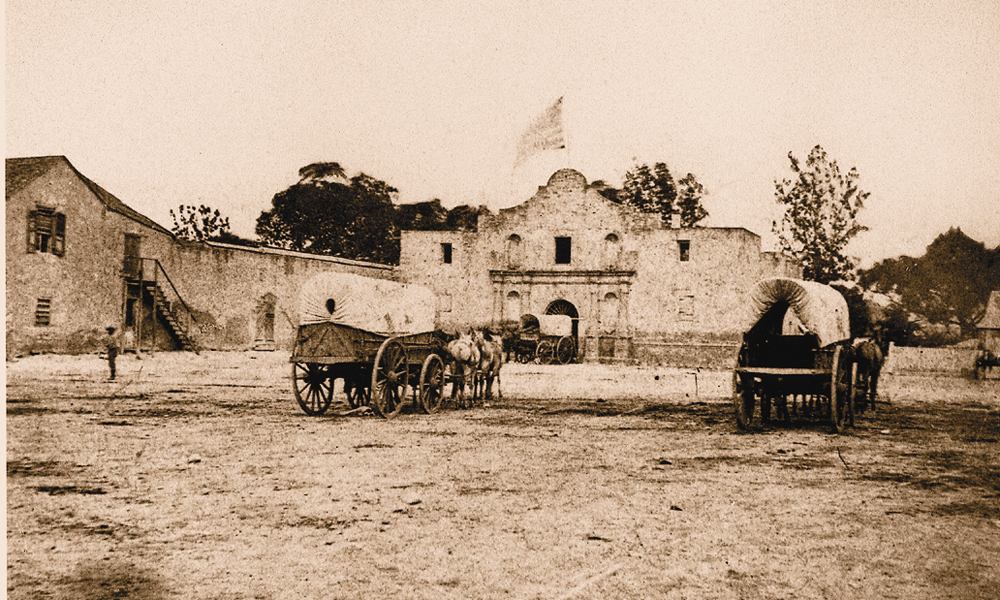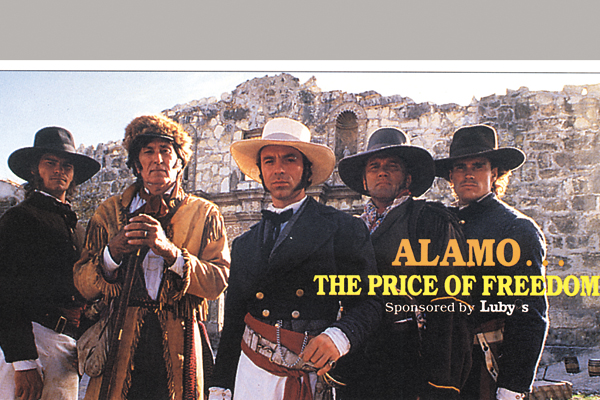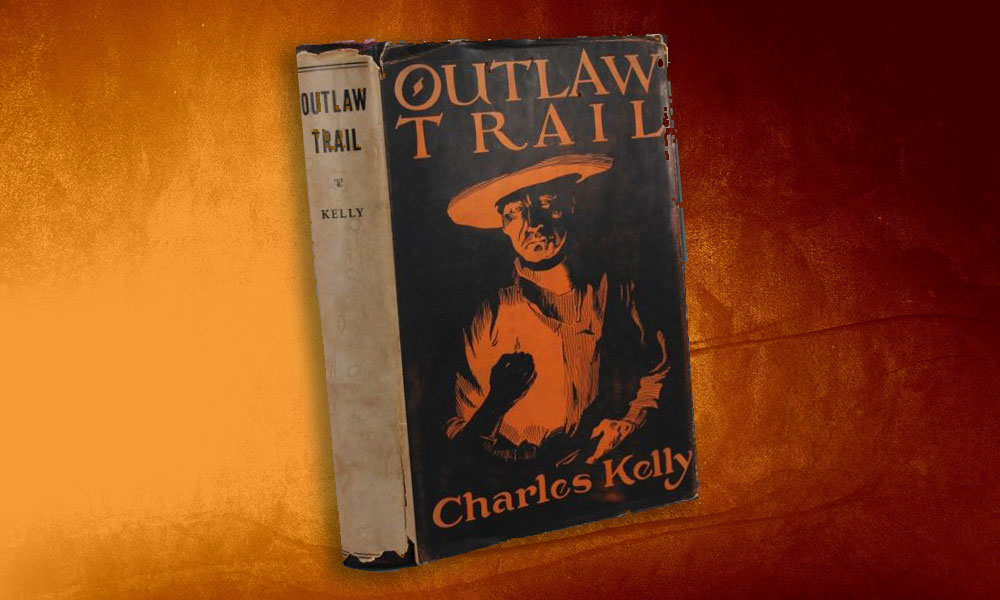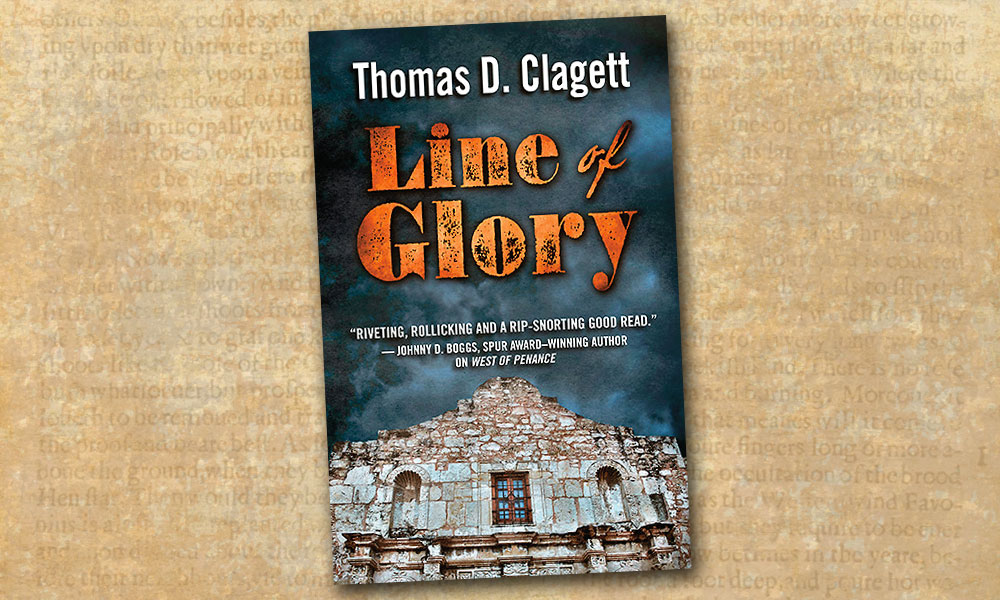My own fascination with the Last Stand known as the Alamo began when, as a kid, I saw Fess Parker as Davy Crockett and movies like The Last Command and John Wayne’s The Alamo.
Although the Alamo is a Texas saga, its universal meaning is evidenced by kids wearing coonskin caps from California to Missouri to Maine.
So what is it that makes the Alamo so appealing, and so important? The men of the Alamo have come down to us with their heroic halo still relatively intact; yet Santa Anna was not too far off when he described them as merely “pirates” and rebels who deserved execution. And while the truth deals with the battle in 1836, I think it’s our individual interpretation that keeps the Alamo alive today.
There is a duality at work here: the history of the fight and the myth of the fight are inseparable, which is why I paint in the style I do— the story is there as the subject, but the myth is there in the abstract quality of the figures.
I was first introduced to my co-guest editor Paul Hutton while listening to a 1986 lecture tape on the Alamo. I’ll never forget the revelation I felt when I realized that he understood both the myth and the history—and he loved them both as I did. So, I called him and introduced myself and, over the years, his impact on my life and work as been enormous. It was the same when I read Bob Bell’s books. I had grown up reading True West, but it all came together when I met him at True West headquarters and realized he was into this stuff worse than I was. So, it is a privilege to tell this famous story with Paul Hutton, his team of authors, and True West magazine, with whom I feel a lifelong affinity.
Finally, as you revisit the 13-day siege, take another look at “the enemy.” It seems to me that we will all wind up in a similar crumbling fortress, surrounded by whatever it is that will end our lives. Then we’ll realize that the enemy is not necessarily evil, he is just “necessary.” We sympathize with those doomed men not merely for their cause, but because of their impending doom. Ultimately, it’s everybody’s Alamo.
—Thom Ross with
Paul Andrew Hutton
The Texans were winning the war. They had won battles at Gonzales and Béxar and forced the occupying Mexican army south of the Rio Grande. But they misjudged the power of Mexican response. The Texians (the term used at the time of the battle) should have known that the Mexican Army was coming. Tejano scout Blas Herrera, reported to Colonel William Barret Travis on February 11 that the Mexican army was advancing toward San Antonio. Travis, at a fandango, replied that he could not stay to read letters, for he was dancing with the most beautiful lady in San Antonio. If the military leader of the Texians did anything other than dance with this intelligence, it has become lost to history.
President-General Antonio Lopez de Santa Anna Perez de Lebron sent two columns to stop the federalist insurrection against his rule. One column, commanded by General of Brigade José Urrea, would take the coast road up from Matamoros through the southern frontier, destroying the Texian garrison at Goliad. The second column would be commanded by Santa Anna himself and would attack from the western frontier, using the El Camino Real as the axis of advance. The two armies would join each other somewhere between the Brazos and Colorado Rivers.
Day 1 • February 23, 1836
Cart wheels
Cart wheels squeaking and oxen lowing were the sounds the Texians awakened to that morning. Many had slept in, it had been a late night celebrating at another fandango on February 22, in honor of Señor Jorge Washington’s Birthday. There were always reasons to have a fandango in Béxar.
The protestations of animal and axle were heard because of the rumor spread among the Béxares the previous evening: the army of Santa Anna was bivouacked on the Rio León, only eight miles away. The population was leaving.
Just after noon, the Texian sentry in the San Fernando Church tower alarmed, “The enemy are in view.” Garrison Co-Commander Travis sent John Sutherland and John Smith to reconnoiter. A short distance west of San Antonio, they found the Dolores Cavalry Regiment preparing to attack the town. Upon the return of the couriers, Travis ordered a retreat into the Alamo.
During the withdrawal, cattle and bushels of corn were purchased from residents of La Villita on the east side of the San Antonio River. Just before abandoning the town to the Mexicans, the Texians raised then lowered a Mexican tri-color flag with two gold stars in the white center portion, representing Texas and Couahila as separate states. This was not yet a war for independence, but a conflict between
federalists (Texians
and Tejanos) and centralists (Santanistas). As the gate closed behind the Texians, the Mexican Army’s Vanguard Brigade, First Division, Army of Operations, of 1,541 soldados, with six cannon and two howitzers, entered the west side of San Antonio. The preferred, or elite, companies of grenadiers and riflemen, two howitzers, and the cavalry moved into Béxar. The two howitzers were placed in battery behind the Veramendi House. The remaining 18 fusilero (musketeer) companies with six tubes of artillery pushed south, down the San Antonio River, to clear Mission Concepción in case more Texians were located there.
The Mexicans raised a blood-red banner with a black skull and crossbones over the San Fernando Church, an indicator that no quarter or mercy would be offered. Immediately, the Texians, possibly ordered by Travis, fired a cannon as a response to the Mexicans’ banner. The other co-commander, Jim Bowie, perhaps more sensitive to the Mexican character, dispatched a messenger asking for a parley and apologizing for the cannon shot. Travis, upon learning this, sent his own messenger to the Mexicans. Both couriers received the same answer: surrender at discretion or be put to the sword. The Texian cannon fired again in final response to the Mexican demand.
Day 2 • February 24, 1836
The well
The well the Texians were so proud of was not providing enough water. This forced them to draw water from the eastern acequia and reservoir, leading to multiple skirmishes, until the well could be improved.
The Mexicans erected a battery just across the river from the Alamo, and late in the day another in La Villita. Pre-combat inspections of the granaderos and cazadóres, and detailed reconnaissance and topography were conducted. The Mission Concepción forces withdrew back to San Antonio.
During the night, the Texians sent out patrols and captured at least one soldado, and used him to help interpret Mexican movements.
At some point Bowie collapsed. The garrison’s surgeon referred to it as “a peculiar disease of a peculiar nature.” Whatever it was, typhoid, tuberculosis, or some odd fever, Bowie collapsed entirely and turned the command over to Travis.
Travis’ first act in command was to compose one of the more stirring pieces of American military literature. Of all his letters (“To the People of Texas and all Americans in the World”), this one would accord the beleaguered garrison the most recognition outside of Texas.
Day 3 • February 25, 1836
A fight, a fire and a faux marriage
The attack position was in the vicinity of the River. General Manuel Fernandez Castrillón, with Santa Anna, com-manded the assault. The column forded the San Antonio River and attacked up through the jacales and out-buildings of La Villita, getting as close to the Texian trenches as 50-100 yards. The Mexicans were driven back after about two hours, suffering light casualties.
While moving toward the Texian outworks, the Mexicans discovered occupied jacales. In one they found a señorita and her mother. Santa Anna became enchanted with the señorita and arranged for a false marriage in order to consummate their relationship. During the fight, the Texians fired at the La Villita buildings closest to the Alamo. David Crockett was also mentioned for the first time in Travis’ dispatches. While holding no official position, his natural leadership caused men to look to him in times of need.
That evening, a Texian council of war was held and Juan Seguín was sent to the colonies with another plea for assistance. Now that they had two battalions on the Texian side of the river, the Mexicans continued placing soldados and guns on all the roads into the area. Within a few days, the Alamo would be surrounded. The First Brigade, commanded by General of Brigade Antonio Gaona, and still making its way along the El Camino Real, was ordered to Béxar.
Day 4 • February 26, 1836
Cold
A norther had blown in. The water situation for the garrison worsened, precipitating a skirmish that erupted in the early hours near the acequia, or reservoir, east of the Alamo. The Texians were repulsed and a larger battle followed. Mexican casualties were heavier than on February 25, due to the four cannon of the corral and church batteries oriented toward the east.
During the evening, the Texians again tried to gather water from the acequia. The cazadóre battalion kept the Texians at bay.
Day 5 • February 27, 1836
Provisions
The Mexicans began this day- with a search for provisions. The town’s limited supplies were diminishing and foraging details were sent out to local Tejano ranches to obtain them. The skirmishes over the eastern acequia were brought to an end when the Mexicans cut the acequia water flow off at the San Antonio River. The Texians would have to make do with their well water.
The permanent Matamoros battalion was repositioned to the south of the Alamo. Once back in La Villita, they began work on entrenchments. Santa Anna inspected them after completion and found the fortifications unsatisfactory. Work continued on the position through the night. The Texians discovered the working party and Santa Anna in the morning, and kept up firing on them all day. Further west on El Camino Real, General of Brigade Gaona received Santa Anna’s orders of February 25 to send three battalions to Béxar. He did not forward any additional artillery because Santa Anna had not requested it. Santa Anna reported his capture of Béxar to Mexico City. The northern battery was positioned near the acequia, about halfway between the north wall and the river. This battery would eventually be advanced to within musket shot of the Alamo.
Day 6 • February 28, 1836
200 Texians and a fiddle
Two hundred Texian reinforcements were reported to be en route from Goliad. The soldados prepared to meet them. The siege continued. Crockett is said to have conducted a concert with the fiddle.
Day 7 • February 29, 1836
Take no prisoners
Santa Anna ordered detachments from the Jimínez Battalion and the cavalry, under General of Brigade Joaquín Ramírez y Sesma, to advance down the Goliad Road. He directed them to attack the anticipated Texian reinforcements at dawn and reminded Ramírez y Sesma that there would be no prisoners during this war.
At about this time, the Mexicans proposed an armistice of three days. The Texians accepted it. Several Tejanos left the Alamo during the abated hostilities.
Day 8 • March 1, 1836
Escape of the mystery man
At 1:00 a.m., 32 Texian reinforcements arrived from Gonzales, bringing the garrison strength to between 180 and 250 men. As they were trying to find a route into the Alamo away from the Mexican lines, a guide appeared who spoke perfect English and offered to escort them into the fort. The Texians initially followed, but then decided to shoot him. The mystery man escaped.
The forces under Ramírez y Sesma advanced toward Goliad as far as the Tinja Creek and then returned to Béxar. The soldados constructed more trenches. The Texians, possibly responding to the armistice or in celebration of the reinforcements or both, fired two 12-pound shots toward town, one of which hit Santa Anna’s quarters.
Day 9 • March 2, 1836
The last to know
The Texians at the Alamo had no way of knowing Texas Independence had been declared at Washington-on-the-Brazos.
Day 10 • March 3, 1836
The letter arrived
At approximately 11:00 a.m., James Bonham, and possibly two other men, entered the Alamo with news of reinforcements. The news, at least in part, contained a letter from Robert L. Williamson, the commander of the ranging companies and friend to Travis. The letter reported that 60 men were due to arrive at the Alamo from Gonzales at any time, and that 600 more men would soon be en route to Béxar.
Across the river, the Mexican army also received good news: General of Brigade Jose Urrea’s column had routed the Texians at the Battle of San Patricio on February 27. The lead elements of Gaona’s Brigade, commanded by Colonel Francisco Duque, arrived in San Antonio bringing two more battalions of infantry and one of zapadores (assault engineers), or 829 soldados. This brought the total amount of soldados to 2,370. Both sides had waited and now both sides had the answer they were waiting for.
Day 11 • March 4, 1836
Tejanas tell all
A Mexican council of war was called. The question was whether to hold the assault until after the remainder of Gaona’s Brigade arrived on March 7, or to assault as soon as possible. Santa Anna reminded those present that there would be no Texian prisoners. This caused a rift in the officer corps, some of whom voiced a strong opinion against execution of prisoners. Santa Anna held firm. The council postponed the decision for the date of the attack to March 5.
Late that night, one or two Tejanas left the Alamo and informed the Mexican army of the Texians’ status—that they expected reinforcements, and of their possible surrender plans if no more Texians arrived. Santa Anna began planning and preparing for the assault phase of the siege. The Mexican batteries moved closer; the river battery and the northern battery were now about 200 yards from the Alamo. There was a possibility of additional Texian reinforcements arriving sometime in the late hours.
Day 12 • March 5, 1836
And the garrison went to sleep
Based on the in-formation provided by the Tejanas, Santa Anna issued his operation order for an assault on the sixth. The plan called for four assault columns, plus one cavalry column and one reserve column. Preparations for combat began immediately. The columns would bed down at twilight. The Mexican bombardment increased in intensity, especially from the northern battery. Sometime during the afternoon of March 5, the column commanders and Santa Anna conducted a reconnaissance of the attack positions and approaches.
Texian sentries were posted and the garrison went to sleep. It is doubtful they expected an assault to happen as soon as the next morning. They had been reinforced once and probably twice.
Day 13 • March 6, 1836
Blood on the morning
At midnight the Mexican Army stirred. The attack columns sleepily formed and began moving toward their assault positions. The 2,064 soldados were organized as follows: column one (355 soldados) was commanded by General Martin Perfecto de Cus; column two (395 soldados) by Colonel Francisco Duque and General Castrillón; column three (430 soldados) by Colonel José María Romero; column four (125 cazadores) by Colonel Juan Morales; the cavalry (369 soldados) by General Ramírez y Sesma; and the reserve (390 granaderos and zapadores) by Lieutenant Colonel Agustin Amat. The attack positions are unknown, but probably were from the northern battery for the first, second and reserve columns; a small entrenchment east of the Alamo for the third column; and La Villita for the forth column. The cavalry established a screen across the Gonzales and Goliad Roads near the Alameda.
Once in position, the soldados lay down and attempted to get a little more sleep. The Texian sentries in the outworks and trenches died silently as soldados bellied up to their positions and knifed them sometime during the night. Just before sunrise at 5:00 a.m. a soldado from the second column could no longer wait and the cry of “Viva Santa Anna!” broke the still morning. Soon the rest of the column seconded the cry. Surprise lost, Santa Anna ordered the massed bands (musicians) to sound the “Atencíon, carga, ó ataque,” and the “Degüello.” The rocket battery fired to signal the start of the assault.
All four Mexican columns surged forward. The Texians were awakened and it did not take long for them to fire their charges into the onrushing columns. The Mexicans paid a high price for their noisy patriotism. Column three, attacking from the east, came under the heavy enfilade fire of the church and corral batteries and was forced north.
Now there were three columns attacking from the north. They shifted into one large formation and lingered at the base of the Alamo’s north wall. Momentum lost, Santa Anna committed his reserve, and it was these grenaderos and zapadores who succeeded in breaching the Texian defense. At the same time, the cazadóre battalion breached the Alamo’s southwest corner from the west side. The Texians withdrew into the adobe apartments, convent and church.
Soldados filled the plaza and the Texians, through loopholes in the buildings, poured a withering fire into them. The abandoned Texian batteries were soon turned around. The room to room fighting in the convent was the bloodiest yet of the morning. The northern columns cleared the west and east walls’ adobe apartments and the convent while the cazadores worked their way down the low southern barracks and into the church.
Somewhere near the end, up to 60 Texians escaped the Alamo, heading east on the Gonzales Road. At the Alameda on the Gonzales Road, Santa Anna’s cavalry made quick work of the fugitives. By 6:30 a.m., the battle had ended. Santa Anna entered the fort along with his escort.
General Castrillón presented him with at least five Texian survivors, one of whom was former U.S. Congressman David Crockett. Castrillón pleaded for lives of the men , but Santa Anna would not hear of it. Several junior officers pulled their sabers and hacked the prisoners to death. According to all accounts, they died with dignity.
The noncom-batant and dependent survivors were escorted by the soldados to the Músquiz house in Béxar where each was questioned, given two silver dollars and a blanket, then released. The Texian bodies were placed in funeral pyres at the Alameda.
The Alamo battle was over. The Mexicans had breached the Alamo’s walls within 30 minutes and completed the executions within the next hour. Casualties for the Mexican Army were at least 60 dead and twice as many wounded. Due to poor medical care, many of the wounded died
The battle of the Alamo, followed quickly by the mass-murders at Goliad, enraged the Texians and their American supporters. Texas forces defeated and captured Santa Anna at the Battle of San Jacinto, April 21, 1836. The Alamo was avenged and Texas was free.
Alan C. Huffines is an eighth generation Texan, an active duty field grade combat arms officer, Persian Gulf veteran, and the author of Blood of Noble Men: The Alamo Siege and Battle, an Illustrated Chronology, and the historical novel, A Pilgrim Shadow. He is a member of Western Writers of America and The Company of Military Historians. He resides in central Texas with his wife and their three daughters. His website is: www.alanchuffines.com







